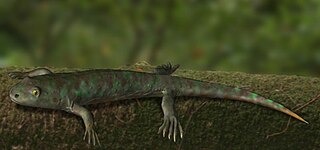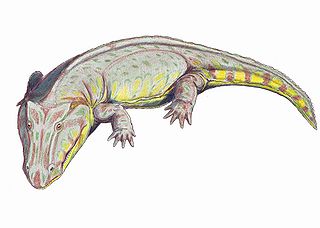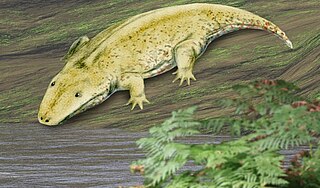 W
WTemnospondyli is a diverse order of small to giant tetrapods—often considered primitive amphibians—that flourished worldwide during the Carboniferous, Permian, and Triassic periods. A few species continued into the Cretaceous. Fossils have been found on every continent. During about 210 million years of evolutionary history, they adapted to a wide range of habitats, including fresh water, terrestrial, and even coastal marine environments. Their life history is well understood, with fossils known from the larval stage, metamorphosis, and maturity. Most temnospondyls were semiaquatic, although some were almost fully terrestrial, returning to the water only to breed. These temnospondyls were some of the first vertebrates fully adapted to life on land. Although temnospondyls are considered amphibians, many had characteristics, such as scales, claws, and armour-like bony plates, that distinguish them from modern amphibians.
 W
WThe Amphibamidae are an extinct family of dissorophoid temnospondyls known from Late Carboniferous-Early Permian strata in the United States.
 W
WBalanerpeton is an extinct genus of temnospondyl amphibian from the Visean stage of the Early Carboniferous period. It reached approximately 50 cm (20 in) in length. Balanerpeton woodi was discovered by Stanley Wood and is the earliest and most common tetrapod in the East Kirkton Limestone of the East Kirkton Quarry assemblage of terrestrial amphibians in Scotland. Characteristics of Balanerpeton woodi include the presence of large external nares, large interpterygoid vacuities, and an ear with a tympanic membrane and rod-like stapes. Numerous studies and research regarding ontogeny in non extant taxa have been oriented around this taxon. The morphology of the stapes suggests that the animal was capable of hearing high-frequency sound. B. woodi does not possess lateral line sulci or an ossified branchial system. The principal method of respiration was probably buccal rather than costal, indicated by the small straight ribs.
 W
WCapetus is an extinct genus of temnospondyl from the Upper Carboniferous of the Czech Republic. It reached a length of 150 cm.
 W
WDendrerpetontidae is a family of Temnospondyli.
 W
WEobrachyopidae is a family of dvinosaurian temnospondyls.
 W
WLaidleria is an extinct genus of unusual armored temnospondyl from Early Triassic of South Africa. Its closest relative was Uruyiella. Laidleria was 30–40 cm in length.
 W
WLatiscopidae is a family of Mesozoic Era amphibian Temnospondyli.
 W
WSaharastega is an extinct genus of basal temnospondyl which lived during the Late Permian period, around 251 to 260 million years ago. Remains of Saharastega, discovered by paleontologist Christian A. Sidor at the Moradi Formation in Niger, were described briefly in 2005 and more comprehensively in 2006. The description is based on a skull lacking the lower jaws.
 W
WTryphosuchus is an extinct genus of temnospondyl amphibian known from the Isheevo Assemblage Zone and Amanakskaya Formation, European Russia.
 W
WUranocentrodon is an extinct genus of the family Rhinesuchidae. Known from a 50 centimetres (20 in) skull, Uranocentrodon was a large predator with a length up to 3.75 metres (12.3 ft). Originally named Myriodon by van Hoepen in 1911, it was transferred to a new genus on account of the name being preoccupied in 1917. It has been synonymized with Rhinesuchus, but this has not been widely supported. It was also originally considered to be of Triassic age, but more recent analysis has placed its age as just below the Permian-Triassic boundary.